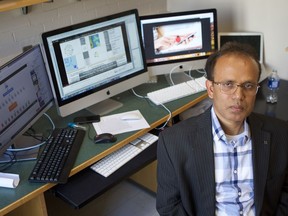Work fighting computer bugs garners international acclaim for U of S researcher
His colleagues say he has taken what was thought to be a niche interest and turned it into a hot topic in computers.

Article content
Chanchal Roy readily admits he’s not ready to ride around in autonomous vehicles.
That may sound odd coming from a rising star in computer science, but Roy is all too aware of the software errors or ‘bugs’ that can cause disastrous malfunctions in automated systems.
In the case of self-driving cars, “it’s still new and I know the complexity,” he said.

An associate professor at the University of Saskatchewan, Roy is making a name for himself internationally for his work on finding, fixing and preventing bugs caused by copied and pasted bits of code called ‘clones.’
Software developers often copy and paste fragments of code, sometimes modifying them, Roy said. In doing so, they can inadvertently copy an error and spread it around.
Software bugs are a gargantuan problem. In 2017, 606 bugs alone cost $1.7 trillion worldwide, affecting 3.7 billion people and 314 companies, — and there are millions of software bugs around, he said.
Roy has been racking up a pile of awards for his work. He recently received an Outstanding Young Computer Science Researcher Award, one of three given out this year by CS-Can/Info-Can, a group that describes itself as “the focal point for computer science research and education in Canada.”
“I was very excited” because Canada has a lot of experts in computer science, Roy said.
He has also won two Most Influential Paper awards at top-ranked international conferences, along with the New Scientist Research Award given by the U of S College of Arts and Science, and the New Researcher Award from the U of S.
Most recently, the U of S nominated him for a Steacie Fellowship from the Natural Sciences and Engineering Research Council of Canada (NSERC). Up to six are awarded each year across Canada, and include both research grants and money to free up the recipient to focus solely on research for two years.
Computer science department head Kevin Stanley said Roy has vaulted ahead in his career by “founding a new subdiscipline,” adding Roy has “not just ridden that wave but kind of led the charge.”
Even so, Stanley said he is “much more interested in the awards (Roy) has yet to win … I don’t think he has peaked by a long shot.”
If not for a gentle nudge from his PhD supervisor at Queen’s, Roy may never have started down this path. He said he thought software clones was a dead topic, but after surveying 225 research papers, he concluded “everything is left to do.”
His findings kickstarted a resurgence of interest. His 2009 paper published in the journal Science of Computer Programming is considered a classic of the field by world leaders in software engineering. It has been cited more than 800 times, the journal’s highest cited paper of the past decade.
That same year, Roy applied for a faculty position at the U of S. It was the only opening in Canada at the time, in the midst of the great recession, he candidly admits. What has kept him at the at the U of S is the friendliness of his colleagues, the presence of other good researchers, and the campus, which he considers one of the most beautiful in Canada, he said.
Stanley, who took part in the decision to hire him, said what struck him about Roy was his “clarity of where he wanted to go and his obvious ambition to get there.”

With the help of 19 graduate students, Roy is continuing his work in developing clone detection tools, along with other tools to help software developers work more efficiently.
Right now, around 80 per cent of their time is spent on maintenance, and only 20 per cent on development, he said.
Roy is not the first in his department to have great success, but he is the “most recent flag-bearer,” Stanley said.
One of Roy’s key mentors in the department, Prof. Kevin Schneider “took that potential and attached rocket engines to it” by helping Roy land funding for his research, which tops $1.5 million so far, he added.
Roy’s distinguishing work on software clones and automated code analysis could also become a signature area for the department, Stanley said. Aiming to build a cluster of expertise, he has recently hired some new people whose work could complement Roy’s.
Zadia Codabux, due to arrive in late July, is working on something called “technical debt.” It’s the computer code equivalent to deferred maintenance on buildings, Stanley explained.
Natalia Stakhanova’s work on computer security includes analyzing viruses to see who wrote them.
Recruiting is one thing; retaining top talent is the other side of the equation. Roy said he turned down an offer from another place last year — he won’t name it — after the U of S persuaded him to stay.
Stanley, meanwhile, is working on a retention plan for the rising stars in his department.
Looking ahead, Roy wants to use clone technology to create software automatically without producing bugs, and to devise an advanced tool for automatic program repair.
They could help overcome the issues with self-driving cars that trouble him now, he said.






Postmedia is committed to maintaining a lively but civil forum for discussion. Please keep comments relevant and respectful. Comments may take up to an hour to appear on the site. You will receive an email if there is a reply to your comment, an update to a thread you follow or if a user you follow comments. Visit our Community Guidelines for more information.